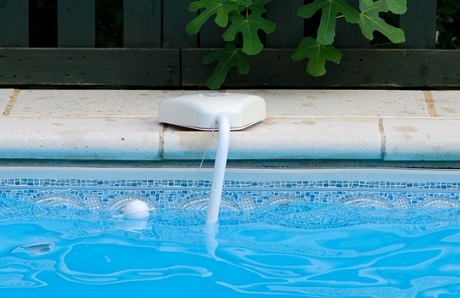—Lower risks and help protect children and pets with a variety of pool security devices
![]()
Even the most attentive swimming pool owners need some backup while striving to keep their backyard safe for children and pets. Let’s face it, young kids and your furry friends sometimes need extra oversight to keep out of harm’s way.
That’s why it’s a smart move to bolster protection with a pool alarm. These devices can warn you immediately when unexpected movement occurs in and around your swimming pool or spa.
Four primary categories of alarms are available to help watch over your backyard oasis. They can be secured to a wall, fence, gate, or door; placed on a pool where they monitor surface breaches; mounted underwater with motion detectors; or, worn by a child as a bracelet (or on a dog’s collar) that reacts to contact with water.
Let’s take a look at each category type and how they operate to sound an alert that someone is entering your pool or the area around it.
Entry-point mounted alarms
Attached to the wall, fence, gate, door, windows, or garage door that leads to your backyard pool, these devices activate with certain kinds of motion.
Some use infrared beams to detect movement. Others sound off when someone breaks a magnetic connection—such as opening a door. Either way, if you hear the alarm, you know that an unexpected visitor has entered the pool area.
Most homes with pools prevent unauthorized entry to their property with walls or fences. In some areas of the country, pools may be on very large lots where the nearest neighbor is a few acres away. In these cases, properties may have no barrier or a simple split-rail fence that a child or adult can easily cross.
Do you already have a wall or fence around your outdoor space where your pool is or will go? If so, you can take advantage of the existing structure by installing one of these alarms atop its perimeter.
Some pool owners add the alarm on the gate of their backyard fence. Another common option is the door of their house that opens to the backyard. If applicable, don’t forget windows and garage doors.
One advantage of these mounted alarms is their “early warning” capability: The alert goes off as soon as anyone comes close to the pool or the area around it—but before they’ve entered the water. In certain cases, this extra warning time could be a lifesaver!
Similarly, there may be times when young children may be playing inside your home—but spontaneously decide to wander into the backyard. With an alarm on the door to your backyard, the device will sound upon the door opening—warning you that the kiddos are on the move toward the pool.
Another upside to these types of alarms: Typically they’re very affordable, with most selling for about $50.
Pool-surface-action alarms
 A surface-action pool alarm.
A surface-action pool alarm.
“Surface-action” pool alarms operate using a sensor device paired with a remote receiver. When they detect wave movement on the water’s surface, the sensor sends a signal to sound an alert.
You install surface-action alarms poolside, along the deck’s perimeter coping. A variety of models are available. For example, one is an L-shaped device. The set-up is simple: Immerse one end in water while the other end supports the alarm atop your deck.
Other types of these alarms are designed to free float like buoys in the water. They use the same sensors and also respond to water surface activity. They require zero installation; just set one out on the water. Typically, they are more sensitive than poolside-attached models.
All these detection devices let you know when a person—or pet—enters or falls into the water. Most feature adjustable sensitivity technology; this feature allows you to decide how big or small of a splash will set off the alarm. If a false alarm does sound—say when the wind blows a plastic deck chair into the pool—you can manually turn it off.
Adjustability is important. You may have a small pet that weighs about 15 pounds, and you want the alarm to sound if it accidentally falls into the water. On the other hand, you do not want the alarm to go off due to heavy rain, strong wind gusts, or leaves blowing into the pool.
While these alarms are effective safety devices, they do provide less response time than do the ones mounted on your wall/fence or gate/door. When your in-pool surface-action device goes off, it means that somebody has already made contact with the water.
With these factors in mind and depending on your particular situation, you may determine that it’s beneficial to install a few different alarm model in and around your pool. For example, combine a gate-mounted alarm with a surface-action unit, which runs roughly $200.
Underwater motion detectors
“Sub-surface” alarms use a sonar grid below the water’s surface to monitor changes in pressure. When the device detects activity, it sends a signal to sound an alarm.
Because they use sonar technology, these underwater units are better at avoiding the false alarms that may occur with surface-action models. Nonetheless, they are highly sensitive. They can detect changes caused by bodies as small as 15 pounds.
Most underwater alarms automatically re-arm themselves after the water has calmed down. Therefore, you will want to deactivate your unit while people are using the pool. Some models let you do this with a key or by entering a code. Always keep the key or code out of the hands of children.
Other models of these underwater come with a handy remote control. A remote makes it fast and easy to deactivate the device when the pool is in use.
When selecting a model with a remote, consider its transmission range. You might think a long range is better than a short one. However, consider how a short-range unit promotes safety: If you can only use the remote when you are at least 10 feet from the pool, this limitation compels you to walk out to the pool (to get into range), and visually survey the area before you can use the remote to turn off the alarm!
Several different models of sub-surface alarms are on the market. They range in style and price from around $300 to $700.
Personal immersion detectors
Pool immersion alarms are specifically designed to track young children and pets entering pools (or other bodies of water).
They come with two components. The first is a wristband that you have your child wear. You can also purchase the device in the form of a collar for your water-loving pooch.
The second component is a base control unit. The base unit plugs into a wall outlet inside your house via a USB cord with a wall adapter.
Inside the wristband or collar, sensors transmit a signal to the base unit when the device makes contact with water. When the device is triggered and sounds off, you know that your child or pet is has entered your pool.
For the device to do its job, your child must wear the wristband (or your pet must wear the collar). Before they go in the pool, you need to remove it.
Take caution: The wristband sounds an alarm only when the child wearing it makes contact with the water; it has no bearing on any other children who might enter the pool.
For this reason, a wristband alarm is usually considered a good backup, or secondary device—not necessarily as a primary alarm system.
Some homeowners opt to buy a pair of base stations, one for inside the house and one for outside by the pool. One base station and wristband cost about $250; you can also purchase additional wristbands and base stations.
Understand local rules regarding pool security
Before purchasing an alarm, it’s a good idea to research safety regulations for your local market. Laws governing pool safety vary by state and municipality. Most cities require that some form of perimeter fencing surrounds a pool and that the fence has self-closing, self-latching gate with the latch at least 54 inches above the ground.
In some cases, such as in California, owners of new pools must install two types of safety features, such as a fence, alarm, or pool cover.
Whether or not you live in an area that requires one or two security levels for your pool, adding an alarm enhances safety; it serves as an extra layer of protection for your family’s well-being.
After all, your backyard pool is about having a healthy, relaxing place for family and friends—and pets—to enjoy. Installing precautionary devices adds to your peace of mind.
Along with regulatory compliance, the type of alarm—or other safety measures—you choose depends on who will be using your pool, who lives in and visits your home.
Finally, along with selecting a quality pool alarm—or several—remember: There is no substitution for consistent adult supervision over children.
You can also educate your family about precautions to take around the pool and backyard. Sharing information about pool safety with neighbors and guests is also a good idea. The knowledge you spread may improve safety practices at everybody’s home.




.jpg?width=1490&name=rock-waterfall-slide-pool%20(1).jpg)